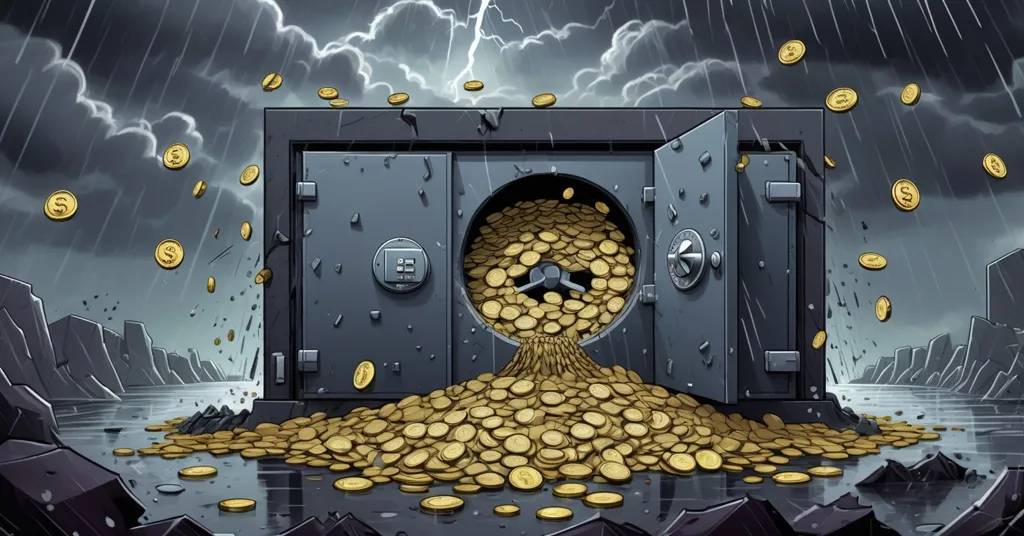Stream Finance Collapses with $93M Loss: DeFi’s Latest Disaster Exposed

Stream Finance Crashes with $93M Loss: DeFi’s Latest Black Eye
Stream Finance, a decentralized finance (DeFi) protocol touting high-yield opportunities through yield farming and trading strategies, has slammed the brakes on deposits and withdrawals after a jaw-dropping $93 million loss in its Stream Fund assets. Blamed on an external fund manager’s murky actions, this disaster has frozen over $160 million in user funds and obliterated the value of its stablecoin, sending shockwaves through the crypto community.
- Massive Loss: $93 million vanishes from Stream Fund due to external manager’s actions.
- Operations Halted: User deposits and withdrawals suspended; $160M locked up.
- Stablecoin Collapse: Staked Stream USD (XUSD) tanks 76% to $0.24 in 24 hours.
The Stream Finance Debacle Unraveled
Let’s cut to the chase. Stream Finance, a player in the DeFi arena offering tools like yield farming (a way to earn returns by lending or staking crypto assets) and delta-neutral trading strategies (a method to balance gains and losses to minimize risk in volatile markets), dropped a bombshell recently. A staggering $93 million of its Stream Fund assets—managed by an external fund manager—disappeared under mysterious circumstances. While the protocol hasn’t spilled the full details yet, the impact is clear as day: deposits and withdrawals are completely shut down, with over $160 million in user funds frozen until further notice. According to data from DeFiLlama, a platform tracking DeFi metrics, Stream Finance’s total value locked (TVL)—the amount of assets staked in its system—plummeted from $204 million in late October to a dismal $98 million. That’s a gut punch to both the protocol and its users.
Who’s this external fund manager, you ask? In DeFi, such roles are often outsourced to third-party entities or individuals tasked with optimizing returns through investments or trading. Unlike centralized finance, where strict vetting and oversight are the norm, DeFi’s permissionless nature often means less scrutiny—sometimes with catastrophic results, as we’re seeing here. Was this manager a rogue actor, or did Stream Finance fail to set proper guardrails? We don’t know yet, but the protocol has hired Perkins Coie LLP, a prominent law firm, to investigate. They’ve also withdrawn all liquid assets as a precaution and promised transparency with regular updates. Fine words, but for users unable to access their savings, it’s like being handed an IOU while the house burns down.
A Stablecoin Turned House of Cards
The carnage doesn’t stop at frozen funds. Stream Finance’s stablecoin, Staked Stream USD (XUSD), designed to maintain a steady $1 value as a safe harbor in crypto’s choppy waters, took a nosedive. In just 24 hours, it lost 76% of its value, crashing from $0.86 to a measly $0.24, per Coingecko data. It’s currently hovering around $0.28, but the trust is shattered. For the uninitiated, a stablecoin is supposed to be a digital dollar—reliable, pegged to a fiat currency like the US dollar. When it “depegs” this badly, it’s as if a dollar bill in your wallet suddenly buys you only a quarter’s worth of goods. That’s the kind of gut-wrenching loss XUSD holders are grappling with.
This isn’t just a localized disaster. The depegging, flagged by blockchain security firm PeckShield as a 60-70% deviation from its peg, has sent ripples across the DeFi ecosystem. Platforms like Euler, a crypto lending protocol, are now at risk of bad debt—loans that can’t be repaid—because they rely on oracles (tools that feed real-world price data into blockchain systems) that haven’t updated to reflect XUSD’s true, dismal value. Think of oracles as a weather app telling a smart contract whether it’s raining outside; if the app’s wrong, the contract makes bad decisions. Here, outdated data could mean Euler and others are overvaluing collateral, a ticking time bomb for further losses.
User Pain and Community Backlash
Imagine being a small investor who staked $5,000 in Stream Finance, hoping for some passive income to offset inflation, only to wake up to a locked account and a stablecoin worth pennies on the dollar. That’s the reality for countless users now stuck in limbo. Social media platforms like X are buzzing with frustration, with some anonymized posts accusing the protocol of negligence, while others speculate the fund manager gambled user deposits on high-risk bets. No evidence of an external hack has surfaced, unlike other recent DeFi incidents, which points the finger inward at potential mismanagement. Even before this collapse, discrepancies in Stream Finance’s TVL data had raised eyebrows among sharp-eyed analysts, hinting at deeper issues beneath the glossy promise of high yields.
Stream Finance’s response, while quick, feels like a Band-Aid on a gunshot wound. Yes, hiring a law firm and committing to transparency is a start, but with funds inaccessible and XUSD in the gutter, users need more than assurances—they need action. Are there plans for a bailout, perhaps through DeFi insurance protocols like Nexus Mutual, which offer coverage for smart contract failures? Or will the community step in with a recovery fund, as we’ve seen in rare past cases? For now, silence on these fronts only fuels the uncertainty.
DeFi’s Broader Struggles: Not an Isolated Mess
Stream Finance isn’t bleeding alone. Just 24 hours before this news broke, Balancer, another DeFi heavyweight, lost over $100 million to a hack, with blockchain analytics firm Nansen tracing pilfered assets to an unknown account. Mikko Ohtamaa, co-founder and CEO of Trading Strategy, suggested systemic flaws like faulty smart contract checks—bits of code meant to prevent unauthorized access—and concurrent transactions throwing off internal accounting could be behind such exploits. Though not directly tied to Stream Finance, his words highlight a grim truth: DeFi’s innovation often outpaces its security.
Look at the numbers, and it gets uglier. A PeckShield report tallies 20 major DeFi exploits in September alone, with losses hitting $127 million—a slight dip from August’s $163 million, but still staggering. Zoom out to the full year, and DeFi losses in 2025 (projected or adjusted for timeline clarity) have soared past $3 billion. Smaller players aren’t spared either; Bunni DEX shut down after an $8 million hack, unable to fund new security audits, though users can still withdraw what’s left of their assets. It’s less Wall Street, more Dodge City—complete with outlaws and no sheriff in sight.
These incidents expose DeFi’s Achilles’ heel: systemic vulnerabilities like smart contract bugs (coding errors that hackers exploit), reentrancy attacks (where a contract is tricked into paying out repeatedly), and flash loan exploits (massive, uncollateralized loans used to manipulate markets). Add to that over-leveraged strategies and sometimes outright incompetence, and you’ve got a sector that’s hemorrhaging trust faster than it can build it. While a 22% drop in monthly losses signals some progress, the sheer scale of 2025’s $3 billion hit shows security still lags far behind the hype.
Playing Devil’s Advocate: Is DeFi Worth the Pain?
Let’s step back and play devil’s advocate for a moment. Some argue these losses are the tuition fee for innovation—a necessary stumble on the path to upending traditional finance. After all, DeFi offers permissionless access to lending, borrowing, and trading, cutting out predatory banks and empowering individuals in ways Bitcoin alone can’t. Yield farming and complex strategies fill niches that BTC, with its laser focus on simplicity and security, doesn’t touch. But at what cost? When users who can’t afford to lose their savings get burned, the “learning curve” excuse starts sounding hollow. Freedom shouldn’t mean playing Russian roulette with your money.
From a Bitcoin maximalist lens—and we lean that way here—DeFi’s quagmire looks like a self-inflicted wound. Bitcoin avoids smart contract chaos by sticking to a battle-tested, minimalist design, prioritizing security over flashy features. It’s not bleeding billions yearly. Yet, we can’t ignore that DeFi’s experimentation pushes boundaries Bitcoin doesn’t, offering tools for financial inclusion that deserve a place in this revolution. The catch? That place can’t be a graveyard for user funds. Both systems have roles, but only one’s proving reliable right now.
A Path Forward for Decentralized Finance
So, where does DeFi go from here? Stream Finance’s implosion is a neon warning sign that the sector needs to grow up—fast. First, protocols must prioritize rigorous smart contract audits by reputable third parties, catching bugs before they become billion-dollar disasters. Second, fund management—especially when outsourced—needs ironclad oversight, perhaps through multi-signature wallets requiring multiple approvals for big moves, a security staple Bitcoiners swear by. Third, insurance mechanisms like Nexus Mutual should become standard, giving users a safety net when things go south. For newcomers, think of this as car insurance for your crypto— not foolproof, but a buffer against total loss.
Stream Finance itself must do more than investigate. If Perkins Coie LLP uncovers foul play, will there be restitution? Transparency is great, but a concrete recovery plan—whether through community funds or external backing—would speak louder. Broader adoption of Bitcoin-inspired principles, like simplicity over complexity, could also guide DeFi’s evolution. Not every protocol needs to be a Rube Goldberg machine of financial wizardry; sometimes, less is more.
Let’s face facts: DeFi isn’t the utopia some shills paint it to be. Yes, its promise of cutting out middlemen and accelerating financial freedom aligns with the disruptive ethos of blockchain and Bitcoin. As champions of decentralization, we’re rooting for it to succeed, especially in niches BTC doesn’t serve. But the brutal truth is, it’s a minefield where one shady manager or unpatched bug can wipe out trust in hours. If DeFi can’t evolve from a risky gamble into a reliable pillar, it risks becoming a punchline rather than a revolution. Until then, disasters like Stream Finance are harsh lessons for anyone wading into crypto’s deepest, most turbulent waters.
Key Takeaways and Questions Answered
- What caused Stream Finance’s $93 million loss?
An external fund manager’s actions are blamed, though specifics await investigation. Community speculation points to risky investments with user deposits, not an external hack. - How are users impacted by this collapse?
Deposits and withdrawals are halted, freezing over $160 million in funds, leaving users unable to access their money until the probe concludes. - Why is XUSD’s stablecoin crash significant?
Dropping 76% to $0.24, XUSD’s depegging shatters trust and risks bad debt on platforms like Euler due to outdated price data from oracles. - What does this reveal about DeFi security risks?
With 2025 losses exceeding $3 billion and parallel exploits like Balancer’s $100 million hack, DeFi’s flaws—code vulnerabilities, mismanagement, and weak controls—are glaring. - Is Stream Finance’s response adequate?
Engaging Perkins Coie LLP and promising updates is a step, but with funds locked and XUSD worthless, users need tangible recovery plans, not just words. - Can DeFi overcome these persistent challenges?
A slight drop in monthly losses shows slow progress, but recurring disasters like Bunni DEX’s closure prove security must catch up to innovation for DeFi to thrive.



